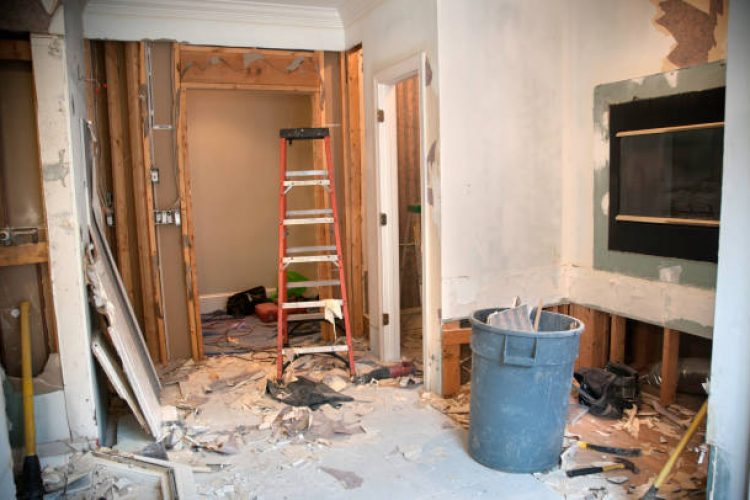Light demolition projects are becoming increasingly common as homeowners and contractors seek to modernize spaces, create open floor plans, and renovate aging structures. Whether you’re removing non-load-bearing walls, tearing up old flooring, or renovating interior spaces, understanding the proper techniques, safety protocols, and industry best practices is crucial for successful project completion.
The Growing Demand for Light Demolition Services
The global construction & demolition waste management market size was estimated at USD 209.5 billion in 2023 and is expected to grow at a CAGR of 5.7% from 2024 to 2030, highlighting the massive scale of demolition activities worldwide. In the United States alone, an estimated 44,000 buildings and 270,000 residences undergo demolition each year, with demolition contributing to 90% of the total construction and demolition waste, while construction only contributes 10%.
This surge in demolition activity reflects changing architectural preferences, urban development needs, and the necessity to upgrade aging infrastructure. EPA estimated that 600 million tons of C&D debris were generated in the United States in 2018, which is more than twice the amount of generated MSW, underscoring the significant environmental impact and economic importance of proper demolition practices.
Understanding Light Demolition: Scope and Applications
Light demolition, also known as selective demolition or interior demolition, involves the careful removal of specific building components without affecting the structural integrity of the overall building. This type of work typically includes:
Wall Removal Projects
- Non-load-bearing interior walls
- Partition walls
- Drywall and plaster removal
- Kitchen and bathroom wall modifications
Flooring Removal Tasks
- Hardwood flooring extraction
- Tile and ceramic removal
- Carpet and padding elimination
- Vinyl and linoleum stripping
- Subflooring replacement preparation
Key Differences from Full Demolition
Unlike total demolition that involves leveling an entire structure, selective demolition involves demolishing only the interior of a building. This targeted approach requires precision, specialized tools, and careful planning to avoid damaging surrounding areas or compromising structural elements.
Essential Tools for Light Demolition Projects
Hand Tools for Precision Work
Sledgehammers and Hammers
Whether you’re busting up concrete or taking out a wall, a sledgehammer is a must-have tool for DIY demolition. However, while a sledgehammer may do more damage with each swing, a standard hammer allows for a more surgical strike. Its lighter weight and compact size allow you to remove smaller sections of drywall without causing the collateral damage that a sledgehammer can cause.
Crowbars and Pry Bars
There aren’t many demolition jobs around that don’t require the use of a crowbar at some point, so it’s a good place to start when collecting demo tools. A well-placed crowbar can safely pry most any kind of nailed wood. It can also be handy for taking up old tile and wood flooring and pulling out stubborn nails.
Specialized Removal Tools
- Demo Forks: When it comes to demolition, it doesn’t get much better than a demo fork. This demo fork from Honey Badger has fangs at the end that you can slide underneath old flooring or roof shingles. Then use the long handle as a lever to pry the materials apart.
- Floor Scrapers: Floor scrapers are tools designed to remove adhesive, vinyl, or soft flooring materials. They are manual or powered, with powered versions offering greater efficiency and speed.
Power Tools for Efficiency
Demolition Hammers
A demolition hammer is sort of like a jackhammer, but in a smaller size that’s suitable for DIYers. The tool’s motor creates a hammering action that drives its chisel-shaped head into concrete, brick, and other masonry. It’s ideal for breaking through concrete slabs or removing old tile.
Circular Saws with Demo Blades
Sledgehammers, pry bars and reciprocating saws aren’t the only house demolition heroes on the job site—your circular saw can be used for a heck of a lot more than cutting studs and sheets of plywood. Fitted with the right blade, your circular saw can cut up roofing, tin, concrete, rebar, steel doors and fiber cement. With a demo blade, you can cut up nail-embedded debris all day long.
Oscillating Multi-Tools
If you have to remove a section of damaged drywall, cut it out with a multitool equipped with a half-moon blade. The tool will cut almost as fast as you can pull it. And because the oscillations on the blade are so short and the teeth are so fine, the tool creates half the dust of a reciprocating or keyhole saw.
Safety Requirements and OSHA Compliance
Regulatory Framework
Demolition work involves many of the hazards associated with construction; therefore, all of 29 CFR Part 1926 – Construction Standards apply at a demolition site. However, demolition involves additional hazards due to unknown hazards, which makes demolition work particularly dangerous. For this reason, OSHA created the Subpart T – Demolition standards specifically for these operations.
Pre-Demolition Requirements
Prior to permitting employees to start demolition operations, an engineering survey shall be made, by a competent person, of the structure to determine the condition of the framing, floors, and walls, and possibility of unplanned collapse of any portion of the structure. The employer shall have in writing evidence that such a survey has been performed.
Even for light demolition, demolition regulations do apply to the removal of ceilings and interior non-load bearing walls and partitions, making compliance with safety standards essential.
Essential Safety Equipment
The employer must determine what Personal Protective Equipment (PPE) will be required. For light demolition projects, this typically includes:
- Safety glasses or goggles
- Hard hats
- Work gloves
- Steel-toed boots
- Dust masks or respirators
- Hearing protection
The essential things you must have before starting any demolition and renovation project is safety gear to reduce the risk of worksite accidents. Buy eye goggles, a helmet, gloves, thick coveralls, boots, air respirator masks, and a first-aid kit.
Wall Removal: Step-by-Step Process
Planning and Preparation
Before beginning any wall removal project, several critical steps must be completed:
- Structural Assessment: Determine if the wall is load-bearing by consulting building plans or hiring a structural engineer
- Utility Location: All electric, gas, water, steam, sewer, and other service lines shall be shut off, capped, or otherwise controlled, outside the building line before demolition work is started. In each case, any utility company which is involved shall be notified in advance
- Permit Acquisition: Check local building codes for permit requirements
- Area Preparation: Clear furniture and create dust containment barriers
Demolition Techniques
Systematic Approach
Except for the cutting of holes in floors for chutes, holes through which to drop materials, preparation of storage space, and similar necessary preparatory work, the demolition of exterior walls and floor construction shall begin at the top of the structure and proceed downward. Each story of exterior wall and floor construction shall be removed and dropped into the storage space before commencing the removal of exterior walls and floors in the story next below.
Drywall Removal
Unscrewing them with a drill is not the most efficient way to remove them because the screw heads are usually deteriorated or full of drywall mud. Use a pry bar or your hammer claw, two of the most essential hand tools for demolition, to pull them out just like you would with nails.
Floor Removal: Materials and Methods
Understanding Flooring Types
It encompasses various types of flooring, including hardwood, tile, carpet, and concrete, each requiring different approaches and tools for effective removal. Understanding the specific characteristics of each flooring type helps in selecting the most appropriate demolition methods and tools.
Demolition Methods by Material
Mechanical Demolition
The process starts with clearing the area of furniture and debris, followed by using equipment like jackhammers, pry bars, or grinders to break up and remove the flooring material, according to a research study by Bharti R et al. 2024, “Study of Demolition and its recent Advancements.” Depending on the flooring type—such as tile, wood, or concrete—the floor demolition technique varies.
Chemical Stripping
Chemical stripping is a floor demolition technique that involves applying chemical agents to soften adhesives or floor coatings, making it easier to peel or scrape off materials like carpet, vinyl, or epoxy floors. This method is particularly effective for floors that are adhered to the subfloor with strong glues or coatings.
Specialized Equipment for Different Materials
Concrete and Masonry Floors
From concrete to tiles, our professionals use systematic ways to remove previous flooring and prepare the area for the next phase of building. We use specialized equipment like concrete saws, jackhammers, and flooring removal machines to handle different flooring materials precisely.
Stubborn Flooring Materials
Some old vinyl sheet or tile floors are super easy to pull up. Others are so thoroughly glued down that you’re lucky to remove quarter-size chunks with every whack of your handheld floor scraper. If a shovel and hand scraper are just not getting the job done in your kitchen demolition, rent a walk-behind scraper. For about $50 to $60 a day, you can save yourself a bunch of time and prevent a whole lot of wear and tear on your back and wrists.
Dust Control and Environmental Management
Health Hazards of Construction Dust
Dust is more than just a tolerated byproduct on the demolition job site. If it’s not properly controlled, it could result in dire health consequences for workers and anyone else nearby. Respirable dust is small enough to penetrate deep into the lungs, usually identified as particles under 10 microns in size (PM-10). These tiny solids that migrate far into the respiratory system are generally beyond the body’s natural cleaning mechanisms such as cilia and mucous membranes, and are likely to be retained.
Dust Control Strategies
Water Suppression Methods
Water used during demolition operations serves as the most popular and practical method for dust control. When applied, it suppresses dust by trapping particles before reaching the air. Wetting: This technique involves soaking the material with water prior to demolition. Water soaks into the materials, resulting in less dust generation during the demolition process. For example, one can use water sprays or hoses aimed at the surfaces being demolished to dampen the material.
Negative Air Pressure Systems
Our first recommendation to control dust during construction work is to use a negative air machine. These machines create negative air pressure inside the area where you’re working. Seal off the work area: Use plastic sheeting and tape to close off all openings in the room except for one door. Position the negative air machine: Place the machine near an exterior window or door for easy exhaust. Install the exhaust hose: Attach the hose to the machine and route it outside through a window or door.
Containment Strategies
In every situation, whether you are removing a load-bearing wall or cutting a few pieces of trim, blowing a fan out the window reduces dust levels and creates a slight vacuum in the work area. That way, any gaps in your dust barrier will let air flow into the work zone, but dust-laden air can’t sneak into surrounding rooms. This works so well, in fact, that you may not even need a dust barrier for light-dust projects, like perhaps in a small kitchen demolition project.
Best Practices for Dust Management
There are a few best practices to keep your work area dust-free and safe. Following these guidelines will help you manage dust levels: Clean as you go: Don’t wait until the end of the project to start cleaning up dust and debris. Isolate the work zone: To block dust from entering other spaces, use plastic sheeting between the work area and the rest of the house.
Waste Management and Recycling
Construction Waste Statistics
In 2018, 76% of all C&D waste in the U.S. was recovered or recycled. Over 95% of concrete and asphalt concrete waste, the largest contributors to total C&D waste, was recovered in 2018. This impressive recycling rate demonstrates the industry’s commitment to sustainable practices.
Material Recovery Opportunities
Most construction projects already heavily use recycled materials, even by accident. Steel, one of the most common building materials in the world, is made of 93% recycled steel scrap, while asphalt concrete is now nearly 100% recyclable.
Proper Disposal Methods
Concurrently, more than 3.57 billion tons of construction and demolition (C&D) waste are produced annually worldwide. Recycling of C&D waste plays a major role in addressing environmental concerns, promoting sustainable construction practices, and circular economy.
Industry Trends and Market Growth
Economic Impact
Industry revenue has been increasing at a CAGR of 3.6% over the past five years to total an estimated $9.5 billion in 2024, including an estimated increase of 4.1% in 2024. Recycling efforts have turned demolition services into lucrative ventures. Rising material costs and environmental concerns drive contractors to prioritize dismantling and recycling, turning old buildings into valuable resources.
Future Projections
Construction and demolition waste market size was valued at USD 219.57 billion in 2024. The market is expected to reach USD 231.19 billion by 2025 and 370.82 billion by 2034, exhibiting a CAGR of 5.4% during the forecast period.
Technological Advances
Innovations such as automated sorting machines, cone crushers, and mobile recycling units are improving efficiency and material recovery rates. For instance, the integration of Artificial Intelligence sorting equipment enables precise separation of materials such as concrete, wood, and metal, reducing contamination and increasing recycling efficiency.
Cost-Effective Project Planning
Labor and Equipment Costs
The demolition industry has shown resilience and growth, with low interest rates in 2020 and 2021 as well as climbing disposable income levels contributed to strong growth in new single-family housing. This strong housing growth contributed to an uptick in the demolition of aging homes throughout the US to replace them with new homes, greatly benefitting contractors.
Efficiency Through Planning
Proper planning is essential to ensure a demolition operation is conducted with no accidents or injuries. This includes, but is not limited to: An engineering survey completed by a competent person before any demolition work takes place. This should include the condition of the structure and the possibility of an unplanned collapse.
Common Mistakes and How to Avoid Them
Inadequate Preparation
Unfortunately, avoidable waste is often caused by inaccurate estimates in orders or incorrect material cuts that result in unusable scraps. Proper planning and accurate measurements can significantly reduce waste and associated costs.
Improper Tool Selection
If you have a tough demolition job ahead of you, you’re going to need a few different options for hammer time. You can do some serious damage to your gas, water and cable lines if you go in swinging. Buy a few different screwdrivers to help with the more delicate work. Taking apart electrical outlets and switches is always the first part of a wall demo and you can’t do that with a sledgehammer.
Neglecting Safety Protocols
However, the hazards of demolition work can be controlled and eliminated with the proper planning, the right personal protective equipment, necessary training, and compliance with OSHA standards.
Conclusion
Light demolition projects require careful planning, proper tools, and adherence to safety regulations to achieve successful outcomes. With the United Nations predicts that by 2050, 68% of the world’s population will reside in urban areas, leading to an unprecedented surge in construction activities and C&D waste generation, the importance of efficient and safe demolition practices will continue to grow.
By following the guidelines outlined in this comprehensive guide, contractors and DIY enthusiasts can complete wall and floor removal projects safely, efficiently, and in compliance with industry standards. Remember that proper preparation, tool selection, dust control, and waste management are key components of any successful light demolition project.
Whether you’re a professional contractor or a homeowner undertaking renovation work, investing in the right tools, safety equipment, and knowledge will ensure your light demolition project contributes to the sustainable transformation of our built environment while maintaining the highest standards of safety and efficiency.













